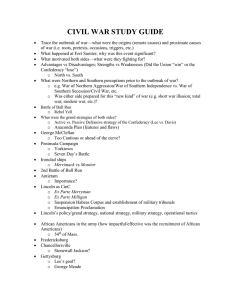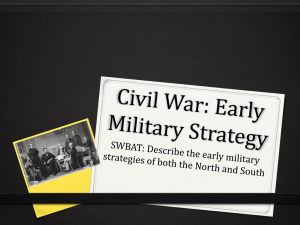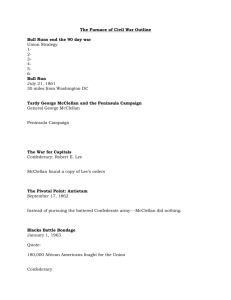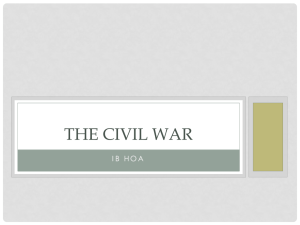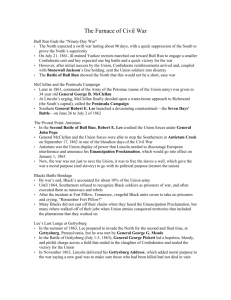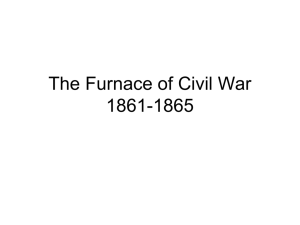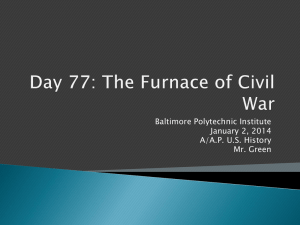Civil War
advertisement
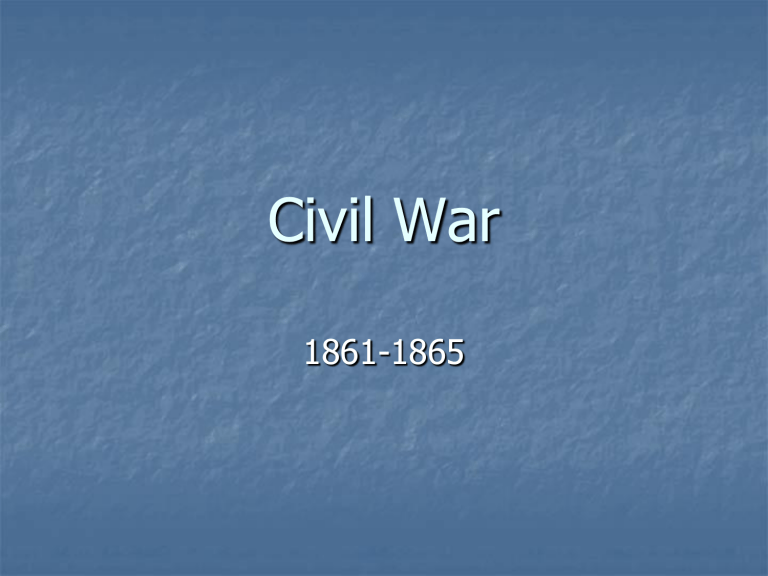
Civil War 1861-1865 VA. 8 West Virginia secedes from Virginia in 1863 and sides with USA. Border states/slaves states remain loyal to the Union Secession •Born in Kentucky •Born in Kentucky •Self-educated •Served as Secretary of War •Congressmen from Illinois •Senator from Mississippi •Abolitionist •Slaveowner •First Presidential candidate for the Republican Party •Served as Secretary of State •Minority president •First and only President of the CSA Lincoln/Davis 22 states 23,000,000 population Industrial economy Majority of transportation Lincoln, a military novice. Asks Robert E. Lee to command Union troops and declines Belief war is about slavery and preserving the Union. 11 states 10,000,000 Agricultural economy Exports, not food Limited manufacturing and railroad lines. Davis, military experience. includes 4 million slaves Better military leaders Belief war is about states rights, independence and preserving their way of life. “The North’s major advantage would be its economy and the South’s main disadvantage was its economy” 100 90 80 70 60 50 40 30 20 10 0 Population Factories Railroads Based on % North South Wealth Farms Cotton Iron Chart: North/South Men Present for Duty in the Civil War Abe Lincoln George McClellan Ulysses Grant David Farragaut George Meade William T. Sherman South Leaders Joseph Hooker George A. Custer Lincoln’s Generals Winfield Scott Irwin McDowell George McClellan Joseph Hooker Ambrose Burnside Ulysses S. Grant George Meade George McClellan, Again! Jefferson Davis Stonewall Jackson Robert E. Lee Pierre T. Beauregard Jeb Stuart James Longstreet South Leaders George Pickett The Civil War Begins 1861 Picture: Fort Sumter 1 Fort Sumter 2 Aggressive War of attrition: South has less manpower… Gen offensive to crush the rebellion. Winfield Scott’s Anaconda Plan Control river systems: Ohio and Mississippi Blockade and seizure of ports War goal: Preserve Union and later abolish slavery Capture Richmond Don’t allow Confederacy to rest. Napoleonic tactics at first----later “trench warfare” Defend and delay until Union gives up. Quick victories to demoralize Union Alliance with Great Britain Capture Washington, D.C. Defend Richmond Sought decisive battle that would convince the Union it wasn’t worth it Use better military leadership to your advantage and outsmart Union generals. Eastern Theater Western Theater Theater/Battles 1862 DATE BATTLE VICTOR July 1861 Bull Run Manasses South Union retreats to Wash. D.C. June 1862 7 Days South Lee stops McClellan from taking Richmond August 1862 Bull Run South Lee stops John Pope from taking Richmond *Sept. 1862 Antietam Draw McCellan stops Lee from taking Washington, D.C. Lincoln issues Emancipation Proclamation *Turning Point battle RESULT Battles in East 1 Battle of Bull Run st (1 Manassas), July, 1861 Lincoln sent 30,000 inexperienced soldiers to fight at Bull Run. Battle of Bull Run st (1 Manassas), July, 1861 Northern troops were pushed back to D.C. South won this battle but “lost the war”. WHY? Failed to capture Washington, D.C. Would never be so close to Washington, D.C. Battle of Antietam “Bloodiest Single Day of the War” September 17, 1862 23,000 casualties •Abolitionists pressured Lincoln to free the slaves. •After the Battle of Antietam, he announced that the slaves would be freed. •Became effective on Jan. 1, 1863, in those states still in rebellion. •Emancipation Proclamation did not end slavery in US •Lincoln’s “first” step towards ending slavery. •“Final step” 13th Amendment to the Constitution on Dec. 1865 would legally and constitutionally abolish slavery. •Freed all slaves in states in rebellion against the US •Did not apply to slaves in border states fighting for US •No affect on southern areas already under US control. •War was NOW fought to end slavery. •US soldiers were “Freedom Fighters” Freedom to the Slave, 1863 •Picture celebrated the Emancipation Proclamation in 1863. •While it placed a white Union soldier in the center: •It also portrayed the important role of African American troops and emphasized the importance of education and literacy. Union Strategy Control river systems and split the Confederacy in half and isolate the 3 sections. Union Leaders: General Ulysses S. Grant Union Army: Army of the West Confederate Strategy Fight a defensive war and drive Union out of South General Ulysses S. Grant Confederate Leader: Several different generals Confederate Army: Army of Tennessee DATE BATTLE VICTOR RESULT Feb. 1862 Fort Donelson Union Controlled the Ohio River March 1862 Fort Henry Union Controlled Cumberland River April 1862 Shiloh Union Controlled Tennessee River April 1862 New Orleans Union Controlled mouth of Mississippi July 1863 Vicksburg Union Controlled Mississippi River * split Confederacy in half *Turning Point Battle Battles in West 1 •Grant captures Vicksburg, splits the CSA in half. •USA controls the Mississippi River. Vicksburg/Gettysburg On July 4, 1863 30,000 Confederate troops defending Vicksburg surrendered their arms. Grant captured 260 cannons, 60,000 stand-of-arms, and more than 2 million rounds of ammunition. Former slaves celebrated Independence Day for the first time. 4 days later, the Mississippi River was in the hands of the Union army Effectively two. cutting the Confederacy in DATE Dec. 1862 BATTLE Fredericksburg VICTOR South RESULT Lee stops Burnside from taking Richmond Jan. 1863 Chancellorsville South Lee stops Joe Hooker from taking Richmond *July 1863 Gettysburg North George Meade stops Lee from moving into Washington, D.C. *Turning point battle Battles in East 2 General George Pickett General Lee orders a frontal assault on Union lines to break through, surround and destroy the North. Gettysburg Casualties •The defeat of Lee at Gettysburg would be the last time Lee would invade the North and try to take Washington, D.C. •Lee’s retreat at Gettysburg on July 3rd and Grant’s defeat of the South at Vicksburg on July 4th would lead to the eventual surrender of the South by 1865. This 1864 presidential election poster supports which political party's position? (A) Whig (B) Know-Nothing (C) Copperhead (D) Republican/National Union (E) Democratic Answer: (D) Republican/National Union Explanation: This poster would have been printed by a supporter of Pres. Lincoln, the Republican /National Union nominee. It sarcastically predicts what would happen if General George McClellan, the Democratic candidate, won in 1864. One of McClellan's main group of supporters was known as Copperheads or Peace Democrats, who urged the Union to approach the Confederacy for a negotiated peace. Though McClellan rejected this plank of the platform, this poster illustrates the defeatist position associated with his candidacy. Presidential Election Results: 1864 The Final Virginia Campaign: 1864-1865 Surrender at Appomattox April 9, 1865 Casualties on Both Sides Civil War Casualties in Comparison to Other Wars Ford’s Theater (April 14, 1865) The Assassin John Wilkes Booth The Assassination Now He Belongs to the Ages! WANTED~~!! The Execution
